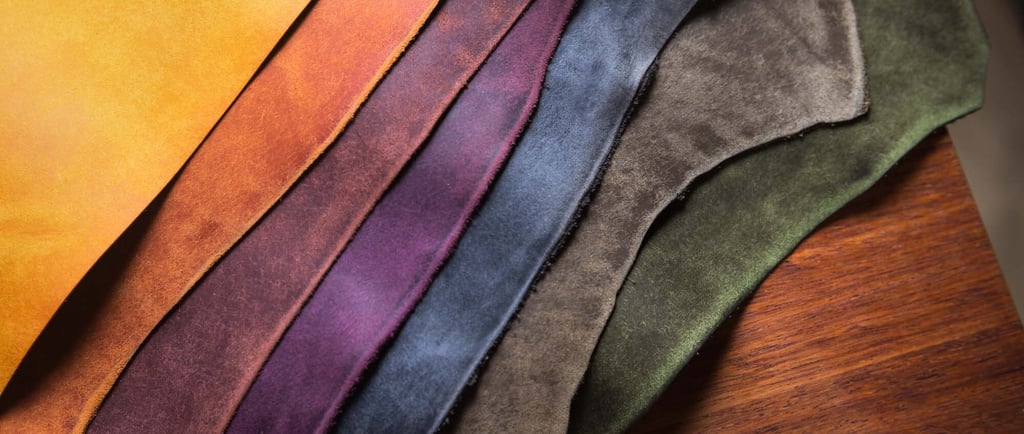A Comprehensive Guide to Vegetable Tanned Leather
Craftsmanship and Sustainability
Vitano Handmade
5/9/20253 min read


A Comprehensive Guide to Vegetable Tanned Leather: Craftsmanship and Sustainability
Introduction to Vegetable Tanned Leather
Vegetable tanned leather is a time-honored material revered for its eco-friendliness, durability, and unique aesthetic. Unlike chrome-tanned leather, which relies on synthetic chemicals, vegetable tanning uses natural tannins derived from plant sources like tree bark, leaves, and fruit. This ancient technique, dating back over 5,000 years, produces leather that is not only sustainable but also develops a distinctive patina over time, making it a favorite among artisans and environmentally conscious consumers.
The Vegetable Tanning Process
The process of vegetable tanning is labor-intensive and can take weeks or even months, but the results are well worth the effort. Here’s a step-by-step look at how it’s done:
Preparation: Raw cowhides are cleaned and soaked to remove hair, flesh, and impurities. This prepares the hide for tanning.
Tanning: The hides are immersed in vats containing tannin-rich solutions made from natural materials like oak, chestnut, or quebracho bark. The tannins bind to the collagen fibers in the hide, preserving it and giving it strength.
Dyeing and Finishing: After tanning, the leather may be dyed using natural dyes or left in its organic state. It’s then stretched, dried, and conditioned with oils or waxes to enhance flexibility and texture.
Quality Control: The leather is inspected for consistency, thickness, and quality before being cut for use in various products.
This slow, meticulous process ensures that each piece of vegetable tanned leather is unique, with natural markings and imperfections that add to its character.
Benefits of Vegetable Tanned Leather
Vegetable tanned leather offers several advantages that make it a preferred choice for high-quality goods:
Eco-Friendly: The absence of harmful chemicals like chromium makes vegetable tanning less polluting. The biodegradable nature of the leather ensures it breaks down naturally, reducing environmental impact.
Durability: Vegetable tanned leather is thick and sturdy, capable of withstanding years of use. It’s ideal for products like bags, belts, wallets, and shoes that require longevity.
Unique Patina: Over time, the leather develops a rich patina as it absorbs oils from handling and exposure to sunlight. This aging process enhances its beauty, making each piece one-of-a-kind.
Hypoallergenic: Free from synthetic chemicals, vegetable tanned leather is less likely to cause skin irritations, making it suitable for sensitive skin.
Aesthetic Appeal: The leather’s natural hues, ranging from warm browns to soft creams, along with its woody, earthy aroma, add a rustic charm to finished products.
Applications of Vegetable Tanned Leather
Vegetable tanned leather’s versatility makes it a staple in various industries. Some common uses include:
Fashion and Accessories: From handcrafted leather bags and wallets to belts and watch straps, vegetable tanned leather is prized for its durability and timeless appeal.
Footwear: Artisans use it to create long-lasting shoes and boots that mold to the wearer’s feet over time.
Furniture and Upholstery: Its strength and aesthetic make it suitable for high-end furniture, adding elegance to chairs, sofas, and headboards.
Bookbinding and Stationery: The leather’s texture and durability make it ideal for journal covers and luxury stationery.
Challenges and Considerations
While vegetable tanned leather has many benefits, it also comes with some challenges:
Cost: The lengthy tanning process and use of natural materials make it more expensive than chrome-tanned leather.
Water Sensitivity: Vegetable tanned leather is more susceptible to water damage and requires proper care, such as conditioning and waterproofing treatments.
Limited Color Options: Natural dyes produce earthy tones, which may not suit those seeking vibrant or synthetic colors.
Caring for Vegetable Tanned Leather
To maintain the beauty and longevity of vegetable tanned leather, follow these care tips:
Clean Regularly: Wipe the leather with a soft, damp cloth to remove dust and dirt. Avoid soaking it.
Condition Periodically: Apply a natural leather conditioner to prevent drying and cracking.
Protect from Water: Use a waterproofing spray to guard against moisture damage.
Store Properly: Keep leather products in a cool, dry place away from direct sunlight to prevent fading or cracking.
Why Choose Vegetable Tanned Leather?
In a world increasingly focused on sustainability, vegetable tanned leather stands out as a responsible choice. Its eco-friendly production, coupled with its durability and timeless beauty, makes it a material that aligns with both ethical and aesthetic values. Whether you’re a craftsman seeking high-quality materials or a consumer looking for sustainable products, vegetable tanned leather offers unmatched quality and character.
Conclusion
Vegetable tanned leather is more than just a material—it’s a testament to craftsmanship, sustainability, and the beauty of natural processes. Its rich history, combined with its modern-day relevance, ensures it remains a favorite for creating heirloom-quality goods. By choosing vegetable tanned leather, you’re not only investing in a durable, beautiful product but also supporting a more sustainable future.
